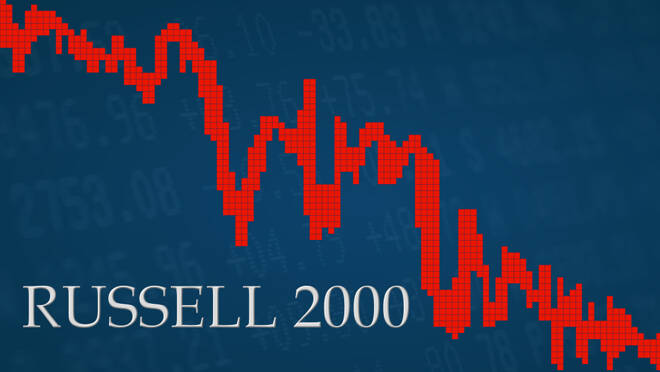Advertisement
Advertisement
What History Says About Russell 2000’s Performance After Market Breadth Hits This Level
By:
After a 20% drop in Russell 2000 since November 2021’s all-time high level, its market breadth dipped below the oversold level last week.
Among the 4 US major indices, Russell 2000 (RTY) is the worst-performing where it corrected 20% from the peak in November 2021 and broke below the major support level near 2100. From Wyckoff trading method perspective, Russell 2000 is about to complete the distribution phase and enter the mark down phase.
Last week I mentioned that the broad market sell-off is very extended and oversold as shown in my market breadth analysis video on S&P 500. Similar situation is unfolding in Russell 2000. Yet, there is an anomaly from the price structure context when analyzing the market breadth.
Using Market Breadth of Russell 2000 To Anticipate A Temporary Bottom
As shown in the comparison chart above between Russell 2000 (RUT) and its market breadth (R2TH) using percentage of stocks above 200-Day average, there is an almost perfect correlation between Russell 2000 and its market breadth.
Since 2014 when the market breadth dipped below the 30% support level, Russell 2000 rebounded off the support (as highlighted in green 6 times) mainly because it reached an oversold level in the short term and a technical rally normalized the situation. Should the rebound fail to overcome the 50% level, the market breadth will dip a lot lower below the 30% level into deeply oversold and capitulation level from 5%-15%, as reflected in 2016, 2018 and 2020.
When only 5%-15% of the stocks are above 200-Day average, the market is in a panic and extremely oversold condition where majority of the sellers are already in position and almost no more sellers left to tank the market further. This corresponds to the market bottom and a sharp rally follows to kick start the bull market.
Last week the market breadth dipped below the 30% level where Russell 2000 was oversold and extended. However, there is a major difference this time comparing to the past when the market breadth dips below the oversold level at 30%.
Russell 2000 Price Structure Context
Previously, when the market breadth dips below the 30% level, Russell 2000 is at or very close to the support from the horizontal trading range. Now, Russell 2000 has committed way below the support of the horizontal trading range near 2100.
In 2014, the market breadth successfully committed above the 50% level and saved Russell 2000 from the tank for at least 1 year. This violated the bearish scenario.
In 2020 during the COVID-19 sell-off, the rebound of the support in Russell 2000 was very weak when the market breath hit the 30% level because of the urgency of distribution from institutions due to the uncertainty of COVID-19. This is considered as a rare event.
Therefore, only the analogues from 2015 and 2018 are used for comparison with the current situation. The rebound in Russell 2000 ranged from 5%-8% after the market breadth dipped below the 30% level in 2015 and 2018.
Although Russell 2000 is way below the support at 2100 unlike the previous analogues in 2015 and 2018, it is still in short term oversold condition pending a technical rebound for normalization. The magnitude of the rebound might not be as strong as in 2015’s and 2018’s. Should a rebound of 8% happen, it will only take Russell 2000 back to test the axis line (where the support-turned-resistance) near 2100, which is still a classical bearish structure for continuation to the downside, as shown below.
Last week Russell 2000 showed climactic volume with mediocre down movement suggested presence of demand in the stopping volume. The bull has secured a chance to prove its worth in the coming week. Should a strong rally unfold and Russell 2000 can commit above 2100, that might violate the bearish scenario. Else, there will be more downside ahead in the near future. Based on the Point and Figure (P&F) chart price target projection, Russell 2000 could test the lower price targets at 1660-1840. Visit TradePrecise.com to get more market insights in email for free.
About the Author
Ming Jong Teycontributor
Ming Jong Tey is a trader who specializing in price action trading with Wyckoff analysis. He is active in swing trading and position trading of stocks in US and Malaysia and day trading in S&P 500 E-mini futures.
Did you find this article useful?
Latest news and analysis
Advertisement
